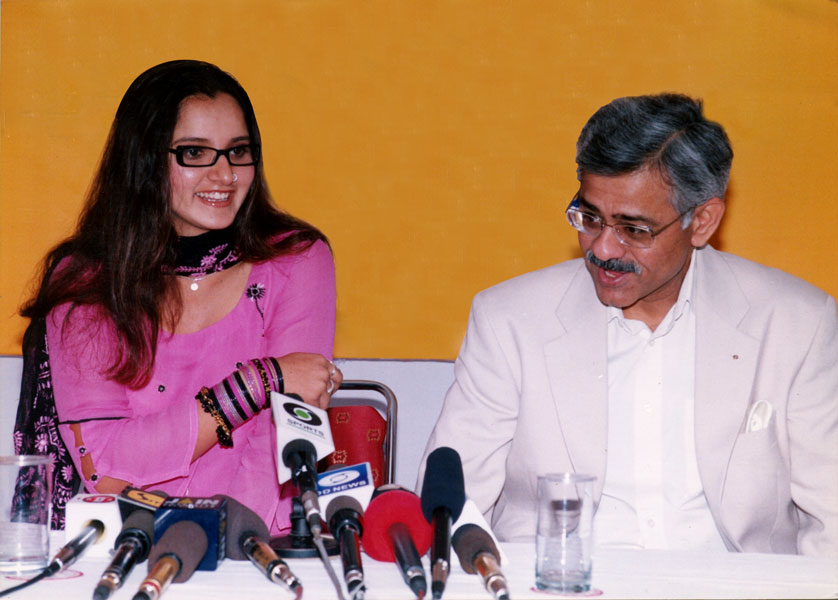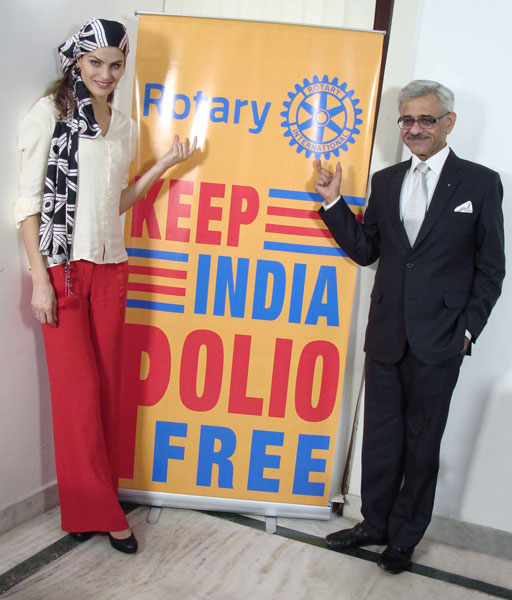To this generation of Rotarians, or Rotaractors, who joined Rotary when India was on the verge of becoming polio-free, or after it became so, it will come as a shock to know that in the early 1980s, India was reporting 450 to 500 new cases of polio every day. And that too when the world as a whole was reporting about 1,000 cases a day!

And we are now talking of barely five cases of polio being reported in the world this year… in Afghanistan and Pakistan! And there have been zero polio cases reported from India in the last four years.
As Rotary in India gets ready to sign an MoU with the Indian Government to join as a trusted partner in its universal immunisation (UI) drive titled Mission Indradhanush (MI), PDG Deepak Kapur, who has so efficiently chaired the India National PolioPlus Committee (INPPC) since 2001, takes a trip down memory lane on his journey in ridding India of polio.
Those were the days when India used to report 450–500 cases of polio every day, when the entire world had 1,000 cases a day.
In 1994, as a young DG — Kapur was all of 36! — he got involved in polio work, but really got absorbed in it the next year when Rotary tied up with the then Health Minister of Delhi, Dr Harsh Vardhan, in the fight to end polio. “Thanks to intense advocacy efforts by senior Rotary leaders in India, he decided to try out supplementary immunisation, which is different from routine immunisation where the numbers were really poor.”
Till then, senior politicians and bureaucrats refused to believe that India could be polio-free. But in 1994, after seeing the “stupendous success” of the first supplementary immunisation that Harsh Vardhan organised, the GoI decided to adopt it as a national programme in 1995, he says.
Biting cold, crowded areas
Kapur recalls that in biting cold all of them would go to Dr Vardhan’s house at 6.30 am and his wife would “give us a cup of tea and from there we would go to very crowded areas to immunise children. Those were the days when India used to report 450–500 cases of polio every day, when the entire world had 1,000 cases a day.”
Which was nearly half the number, I gasp. “Oh yes, and later on, it became more than half, when things started getting better controlled in the Americas and elsewhere, and the Indian statistics became worse!”
In 2001 he was made the INPPC Chair. “By 2000 we had come down to 265 cases and in 2001, 268 cases. So everyone thought the job was done. But in 2002 we had what we call the mini-outbreak in UP, which was a setback. And for years we saw the see-saw of P1 going up and P3 coming down.”
Kapur explains there are three polio viruses, which are classified as P1, P2 and P3. The last case of P2 was from Aligarh in 1998, and then it was gone! India was left with P1 and P3 virus. P1 was then considered much more virulent because the symptoms were more severe and it could travel long distances unlike P3.
UP, Bihar worst hit
In the “mini-outbreak” stage, UP and Bihar were the worst hit due to high population density. “I have seen 32 people living in a 15 sq yard plot in a place in UP, barely 30 minutes from Delhi. The day shift people would sleep there at night and vice versa. People in such areas were living in terrible insanitary conditions. Human refuse floated around in dirty water and the people were drinking water from a pond where buffaloes covered in mud were bathing.”
Kapur says what is most scary is that in some of these areas such conditions remain even today and “that is why there is danger of polio returning if we are not vigilant.”
You guys are holding the world to ransom; it is because of you Indians the world is not polio-free.
— Bruce Aylward, WHO
Another problem was malnutrition in the children which prevented the vaccine from forming antibodies in the child, rendering the vaccine ineffective. While in the US children were being given three doses for polio, in South India “we were giving 7–8 doses but in UP we had children getting as many as 20 doses of the vaccine and yet getting polio,” he adds.
Add to this situation, the prevalence of intestinal diseases in children. “So the child was like a bucket with a hole at the bottom. You kept pouring the vaccine and it came out from the other end, not staying in the body long enough to make the antibodies.”
Periods of despair
So did he and the other leaders have periods of despair, I ask him.
“Plenty; I used to speak to PRIP Kalyan Banerjee and Trustee Sushil Gupta, and wonder whether India would ever become polio-free,” he says. He recalls a particular meeting of an Advisory Group that advised the GoI, in which “only government officials, people from UNICEF and WHO were allowed but not we Rotarians. At one such meeting in Lucknow, Banerjee, who was then a TRF Trustee, said TRF gives so much money for polio and how can they not allow us. It was 2001, I had just become the INPPC Chair; we just walked in and ever since, we belonged there! It was frustrating to be treated as just the moneybags to begin with!”
India becomes Polio-free
Bruce Aylward, who headed the polio programme worldwide in WHO for long years, came to India in 2001 and said: “You guys are holding the world to ransom; it is because of you Indians the world is not polio-free. I prophecy that India will be the last country in the world to be polio-free, and in India, UP will be the last State, and in UP the last town will be Moradabad.’
Recalling these words, Kapur says that there were four polio capitals in the world in those days — Moradabad, Bareilly, Badayur and Rampur, all four in western UP! “What was called the ‘Moradabad-virus’ has infected children in every continent in the world; it has travelled to Africa, the Americas and Europe.”
My fear is that world will, within two years, report 500 cases of polio every day! And from where are you going to find the same funds, the same commitment, the same passion to begin anew?
There were lots of moments of despair, “lots of occasions when we felt so discouraged. But then one fine day, as President-elect of RI, Banerjee said at a meeting, very empathetically: “We-will-get-rid-of-polio-next-year. And it happened! On January 13, 2011 we had the last case of polio in India in his year as RI President and that was totally amazing! I had thought he was being very rash. But it happened. And three years later came the certification!”
Coming to the present and the near future, Kapur is apprehensive that Indian Rotarians have slackened on the polio front. “They have taken up other things; there are so many needs… the feeling is that it is over and polio is not going to return. But it was due to such complacency that so many other countries such as Indonesia, Kazakhstan, China, Bangladesh, Nepal got it back; China got it back from Pakistan and others got it from India!”
Striking an ominous note, Kapur says that in case polio returns to India and our response is not swift and it is not controlled immediately, “my fear is that world will, within two years, report 500 cases of polio every day! And from where are you going to find the same funds, the same commitment, the same passion to begin anew? So keeping India polio-free is absolutely crucial in this battle.”
Photo Courtesy: INPPC, Delhi.
Resistance from Muslims
One of the biggest challenges of the polio eradication drive in India was the huge resistance from the Muslim community, particularly in UP and Maharashtra.
INPPC Chair Deepak Kapur recalls that once, in the Kundarki block in UP, in one particular Muslim household reputed to be very resistant to polio immunisation, the door was opened by a woman holding a child in her arms. “We said, may we immunise your child? We had been told they will hit you, throw you out, but she said ‘sure’. We were surprised, and a couple of guys moved forward to give the drops. But I said: ‘Hang on’; the body language was not right. She was so tense. So I asked her what will you do after we put the drops in the child’s mouth and go away? And she said I will dash his head on the floor and kill him. Totally shocked and shaken, I asked why and she said if I don’t, my husband will come home in the evening and kill me. So we quietly went away.”
Such fear was twofold; the Muslims were told the medicine is haram (forbidden) for Muslims as it had parts of pig in it. And two, it was a plot of the American and the Indian governments to limit the number of Muslims in India.
Once in Rampur, he saw a rag of a newspaper which barely printed 200–300 copies propagating this crazy theory. “The reason behind this story was that this guy had asked a local Rotarian for an ad which cost some Rs 500 or 600 and was refused and this was his revenge. But such gossip picked up like crazy. We fought such false propaganda by setting up Muslim Ulema committees. Past president Ajay Saxena was instrumental in getting together many of these maulvis in UP and I requested PRID Ashok Mahajan, my batchmate and dear friend, to take it forward in Maharashtra.”






